Events of 29th December 2015
In 2015, Christmas day fell on a Friday, so the official Boxing Day holiday was moved to Monday, 28th December. Bus and rail services were expected to resume on the following day but I thought it might be safer to defer any trip until Wednesday. However, following a wet, overcast and windy Boxing Day where I live (there had been serious floods in parts of the country), Tuesday was dry and wind-free so, on the spur of the moment, I left my home to catch the first bus of the day to Wolverhampton. Somewhat to my surprise, the bus arrived on time and made good progress to Wolverhampton.
I walked from the bus to the railway station (which is often now called the 'train station' - an Americanism I'm not fond of). Although I had an idea of my preferred destination, I asked the fares to three different places but, since the Booking Clerk knew me, she did not find the multiple enquiries unexpected. Whilst I understand a little about railways, the various ticket prices and restrictions which apply nowadays tend to defeat me. I sometimes book tickets on the internet but I always retain the suspicion that there is a better fare, if only I could work it out.
Regular readers will not be surprised at my decision to purchase a return ticket to Liverpool - it's a city which always attracts me and, if the weather became poor, there would be plenty of things to see indoors.
There was about 15 minutes to wait before the direct service but I was in time to board the earlier 'Virgin' 'Pendolino' service to Edinburgh, changing at Crewe. When running correctly, I admit to being impressed by the 'Pendolino' trains. We made the non-stop journey to Crewe in just over 30 minutes.
Crewe
Of course, on arrival at Crewe, I had to wait for the following 'London Midland' direct service to Liverpool to arrive but I'm always happy to wander round the station, principally looking at the architecture.
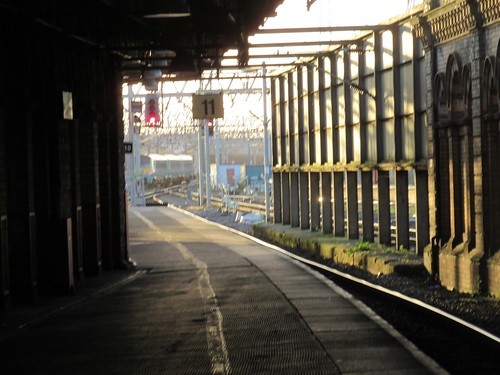 Crewe Station: View from platform 11 (former platform 3) looking south, showing LNWR screen. An 'Arriva Trains Wales' DMU is departing for Shrewsbury.
Crewe Station: View from platform 11 (former platform 3) looking south, showing LNWR screen. An 'Arriva Trains Wales' DMU is departing for Shrewsbury.
There are a number of earlier posts on Crewe, such as Crewe Station. There are also two collections of pictures which get added to from time to time Crewe Station Buildings: L&NWR and Crewe Area rail.
The 'London Midland' service to Liverpool arrived about 5 minutes late - the usual 4-car 'Desiro' Electric Multiple Unit. By the time all the waiting passengers had boarded, there were only a few seats left empty.
Crewe to Liverpool
We set off for Liverpool, stopping at Winsford, Hartford, Runcorn and Liverpool South Parkway. It's fairly hopeless trying to take pictures from modern trains with double-glazed windows and brightly-lit interiors but the collection Liverpool area rail has a number of pictures taken between Crewe and Liverpool.
On this journey, as we crossed the Dutton Viaduct over the River Weaver, the sky was blue and the sun was shining, making it hard to believe it was December and I decided I might have picked the right day for my trip.
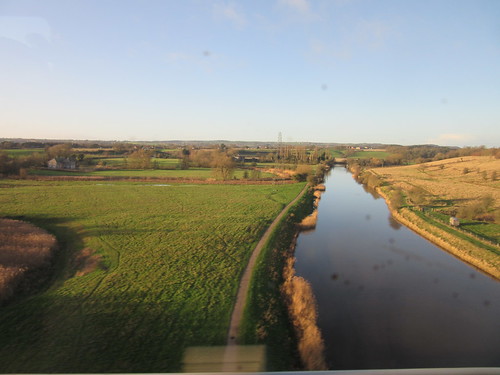 The view west as we crossed the River Weaver on the Dutton Viaduct.
The view west as we crossed the River Weaver on the Dutton Viaduct.
At Weaver Junction, we left the West Coast Main Line to the north, diverging onto the Liverpool Line. The gradient diagram from Weaver Junction to Liverpool Lime Street is reproduced below. In steam days, firemen could be anxious as to whether they'd be able to generate sufficient steam to get over the next summit and then be able to re-fill the boiler. With powerful modern electric trains, the profile of the line is of less importance, although it's still necessary to understand how the gradient will affect braking at any point on the route.

Gradient diagram Weaver Junction - Liverpool Lime Street.
We made a brief stop at Runcorn, crossed the Manchester Ship Canal and the River Mersey on the three spans of the Runcorm Railway Bridge (built in 1868) and, after galloping past Ditton, Halewood and Speke, were soon making our stop at Liverpool South Parkway. I still can't get used to the huge, modern transport interchange here.
 Liverpool South Parkway.
Liverpool South Parkway.
A few more minutes took us past Mossley Hill and Wavertree to curve left on the approach to Edge Hill where we briefly joined the historic route of the 1830 Liverpool and Manchester Railway, now electrifed throughout. We then diverged from the route to the original Crown Street terminus to descend through the remarkable sandstone cutting to our final destination, Liverpool Lime Street. This cutting does not form part of the original 1830 line. Because of the commercial success of the Liverpool and Manchester Railway, in 1837 a double track tunnel, initially cable-worked, was constructed from Edge Hill to a new station at Lime Street. Continuing growth in traffic resulted in work starting in 1881 to open-out the 2-track tunnel into the four track cutting which remains in use today. There's a post with more information about the construction of the cutting here.
I've posted a video of a similar London Midland electric multiple unit passing through the cutting from Edge Hill to Lime Street on 26th March 2015. To view the video Click here. When you've viewed the video, you can use the 'Back Button' to return to this post. This video was made on the day I travelled to Irlam, for the Irlam Station Launch. The journey itself is described in the post By Train to Irlam but note that the section 'SIGNALLING FROM WOLVERHAMPTON TO LIVERPOOL is already out of date since (as anticipated) Wolverhampton Power Signal Box, Stafford No. 4 signal box and Stafford No. 5 signal box have now been abolished.
Liverpool
I'm always drawn to Pierhead, now marketed as part of Liverpool Waterfront. It's very different from my childhood memories, when there was the Liverpool Overhead railway, electric trams, steam locomotives fussing around on the dock lines, and frequent Mersey ferries coming and going across the river, but it still has the amazing river and retains a limited ferry service.
The Museum of Liverpool, 'Lion' and the Old Locomotive Committee
A modern addition to the area is the Museum of Liverpool which displays the 1838 locomotive 'Lion'. As I'm currently Secretary of the 'Lion' supporters' club 'The Old Locomotive Committee' (usually called 'OLCO'), I try to 'pay my respects' to the locomotive when I'm nearby.
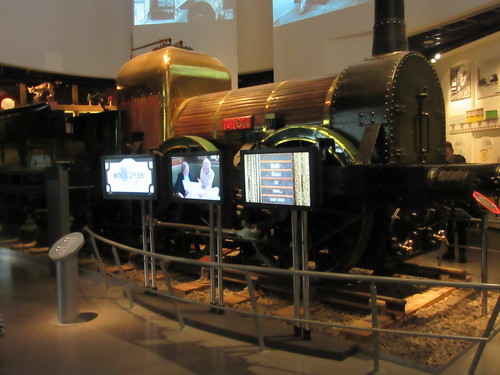 Museum of Liverpool: 'Lion'.
Museum of Liverpool: 'Lion'.
My introduction to 'Lion' and the activities of OLCO is here. All my posts about 'Lion' and OLCO activities can be found here.
OLCO has its own website dedicated to 'Lion' and models of 'Lion' here.
The Museum of Liverpool website has a page on 'Lion' here which includes links to two video interviews, 'Lion's Story' (with the Museum's Curator of Land Transport Sharon Brown) and 'Lion takes centre stage' (with two Officers from the Old Locomotive Committee, John Hawley the Magazine Editor and, ahem, Jan Ford the Secretary). 'Lion takes centre stage' is also available to museum visitors on the display screens next to the exhibit by pressing a button.
There's a short post on the making of 'Lion takes centre stage' here, more about the Museum of Liverpool and the way 'Lion' is displayed in the post Royal Visit to the Museum of Liverpool and a brief description of the complex Audio Visual Installations at the Museum here.
It's a great Museum and there were plenty of visitors enjoying the displays but I'm not a fan of the museum's modern architecture. Having checked that all appeared to be well with 'Lion', I walked to the nearby Mersey Ferry Building (another ghastly, modern affair) to board the next ferry.
 The Museum of Liverpool.
The Museum of Liverpool.
'Ferry cross the Mersey'
I was surprised at how many passengers were queuing for the eleven o'clock sailing, operated by the ferry 'Snowdrop', still in her 'DAZZLE' paint scheme I complained about in an earlier post here. The river was like a millpond, there was no wind and the sun beamed down on us as we made our crossing to Seacombe ferry terminal. It was such a glorious day, I decided to disembark at Seacombe and walk along the Promenade to New Brighton.
On Foot to New Brighton
The promenade from Seacombe to New Brighton looked inviting in the unexpected sunshine. There were a number of rod and line fishermen engaged in their hobby, together with joggers, dog-walkers, bicycles and casual walkers. There was the atmosphere of a seaside resort and, although Liverpool north docks were clearly visible on the opposite bank of the river, they didn't seem obtrusive.
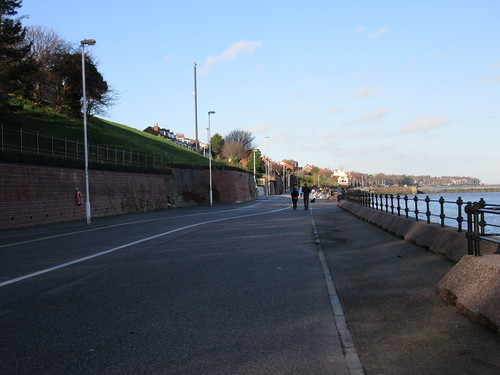 The Wirral: The start of the Promenade from Seacombe to New Brighton.
The Wirral: The start of the Promenade from Seacombe to New Brighton.
After passing the imposing bulk of Wallasey Town Hall (there's an article on its history here), I came to the traditional public house called 'The Ferry' at Egremont. In the picture below, you can see the first five massive new red-painted container cranes of the new 'Liverpool 2' port facility.
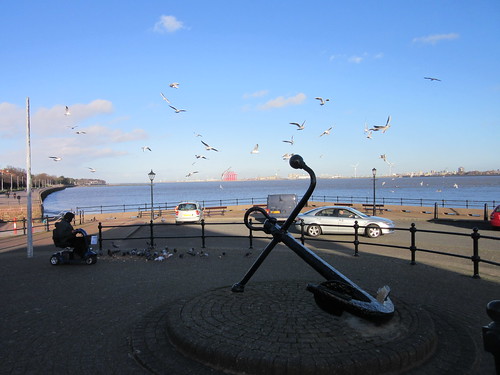 The Wirral: The Promenade from Seacombe to New Brighton at Egremont, looking seawards.
The Wirral: The Promenade from Seacombe to New Brighton at Egremont, looking seawards.
Egremont is also the location of Captain's View which not only has a first floor apartment you can rent but is the site of one of the Wirralcam web cameras.
Using the 'Wirralcam' site, you can observe shipping on the Mersey from anywhere in the world. Supplement the pictures with ship data and position information on the River Mersey page from Ship AIS and you have an addictive 'virtual reality'.
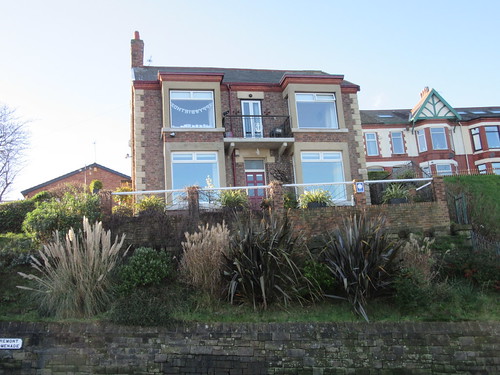 The Wirral: 'Captain's View', Egremont, viewed from the Promenade from Seacombe to New Brighton.
The Wirral: 'Captain's View', Egremont, viewed from the Promenade from Seacombe to New Brighton.
As I continued walking, I watched two tugs assisting a bulk carrier which was leaving the north docks stern-first. If you're interested, a telescope, binoculars (or the 'zoom' on a modern camera) can show a lot of detail.
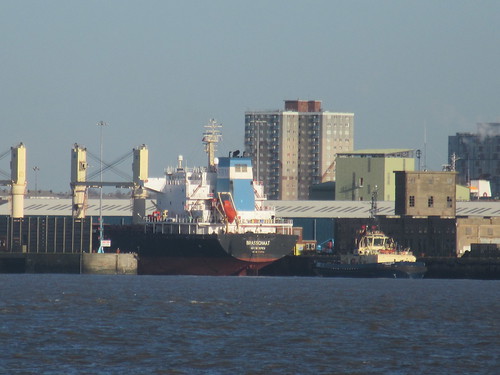 Liverpool Docks: Bulk Carrier 'Brasschaat' leaves the docks, stern first, assisted by two tugs.
Liverpool Docks: Bulk Carrier 'Brasschaat' leaves the docks, stern first, assisted by two tugs.
As I continued, I passed the War Memorial for World War I which faces the river.
1914 - 1919
TO THE GLORY OF GOD
AND IN HONOUR OF THE
BRAVE MEN OF THIS BOROUGH
WHO SERVED IN THE GREAT
WAR AND TO THE LOVING
MEMORY OF THOSE WHO
MADE THE SUPREME SACRIFICE
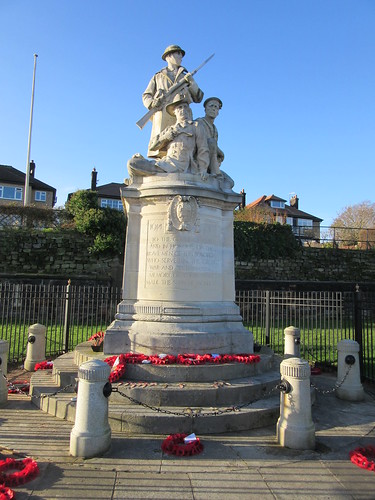
The Wirral: War Memorial 1914-1919 on the Promenade from
Seacombe to New Brighton.
Once having released her tugs, I was surprised at the speed with which 'Brasschaart' (operated by Sobelmar, Antwerp) headed for the Irish Sea. The picture below shows one of the two tugs posed in front of the Liverpool Bulk Terminal (briefly described in my post On foot around Liverpool Docks (3).
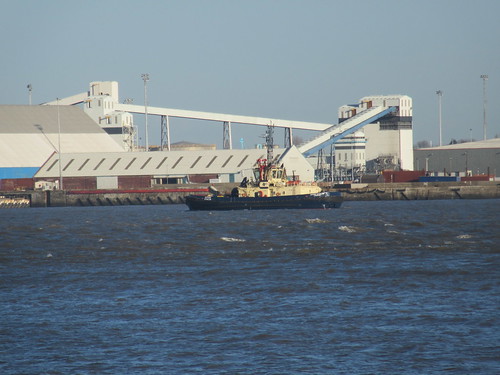 Liverpool Docks: Tug 'Svitzer Stanlow' after assisting 'Brasschaat', with Bulk Materials Storage conveyors in the background.
Liverpool Docks: Tug 'Svitzer Stanlow' after assisting 'Brasschaat', with Bulk Materials Storage conveyors in the background.
Quite unexpectedly, I came upon a 'pirate ship' made out of driftwood by 'PIRATES AT ART' (geddit?). I'm normally immune to Art Installations but I found the 'Black Pearl' charming. I saw a number of parents watching their children as they went inside the hull and climbed up to the deck. A very gentle 'Health and Safety' warning was posted on the promenade.
PIRATES AT ART want you to enjoy this Art installation. As it is an open access piece of work we ask you to take responsibility for yourself and those in your care. Please supervise your children at all times.
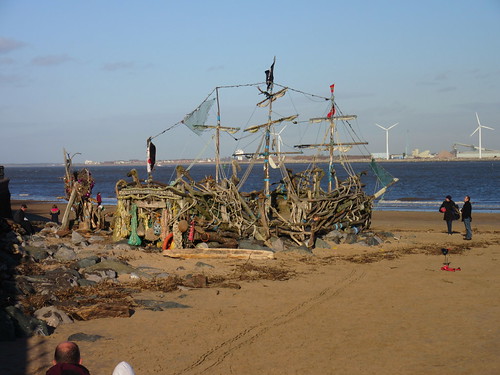 'The Black Pearl' New Brighton.
'The Black Pearl' New Brighton.
As I approached New Brighton, the size of the five massive new red-painted container cranes across the river at the 'Liverpool 2' terminal became more apparent. With the booms horizontal (as in the picture below) each stands over 300 feet tall and weighs 1600 tonnes. What I find more amazing is that all five cranes arrived fully assembled carried on a single ship 'Zhen Hua 23' after a 18,000 mile journey from Shanghai. The arrival, in November 2015, is described in SHIP-TO-SHORE CRANES ARRIVE.
 Liverpool Docks: The first five Container cranes at 'Liverpool 2'.
Liverpool Docks: The first five Container cranes at 'Liverpool 2'.
By the time I reached Fort Perch Rock, I decided I'd nearly had enough walking, so I walked inland along Victoria Road towards the railway station.
 New Brighton: Fort Perch Rock, with the lighthouse in the background.
New Brighton: Fort Perch Rock, with the lighthouse in the background.
By rail to Hamilton Square
On the way to the station, I paused at a Fish and Chip shop to buy a can of soft drink and a very generous portion of chips. I soon reached the railway station and managed to finish my chips before boarding the electric train to Birkenhead Hamilton Square. There's a little about this line and its origins here.
'Resurgam'
A short walk took me from the station to the Woodside Ferry Terminal. With a few minutes in hand before the arrival of the ferry to Liverpool, I decided to have a better look at the replica of an early submarine displayed outside the terminal. It is a full-size replica of 'Resurgam' built by trainees of Rathbone C.I. in 1997.
The Rathbone family were merchant traders with a social conscience who were founding members of the Liverpool Committee for the Abolition of Slavery. Rathbone C.I. was formed in 1995 by a merger of Rathbone educational charity work with a similar charity - Community Industry.
A brass plate on the replica gives a brief history of the original vessel:-
RESURGAMThere's more information in the Wikipedia article Resurgam.
Built in 1879 by J. T. Cochrane, Cleveland Street, Birkenhead
Designed by Reverend George Garrett (1852-1902)
"RESURGAM" - Latin for "I shall rise again"
This is a full-size model of one of the first submarines ever built. She was designed by Reverend George Garrett, a curate in Birkenhead who was a trained chemist. The construction was of iron and wood, 45 feet (14m) long, 10 feet (3m) in diameter and weighing 330 tons; she cost £1,538 to build. She was powered by a closed cycle steam engine and crewed by 3 men.
Trials in the East Float of Birkenhead Docks and at sea showed that she did sail and submerge, if only briefly. This was the first vessel to be successfully propelled mechanically underwater.
On her way to Portsmouth for a demonstration to the Royal Navy in February 1880, she sank in a storm 15 miles off Rhyl. The wreck was only found in 1995.
The model was built by AMARC trainees in 1997 and was refurbished in 2009 by the Maritime & Engineering College North West, Monks Way, Birkenhead.
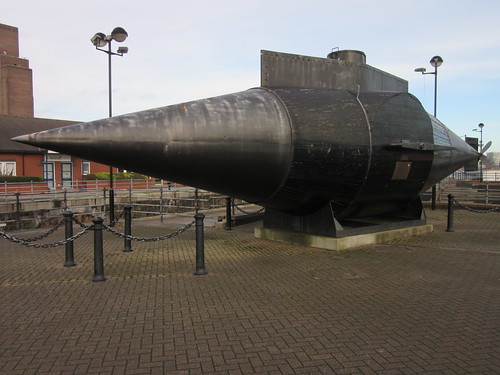 Replica of 'Resurgam' outside Woodside Ferry Terminal.
Replica of 'Resurgam' outside Woodside Ferry Terminal.
By Ferry to Pierhead
The ferry 'Snowdrop' arrived as scheduled from Seacombe but it took a short while to tie-up as a wind had started up and the river was far more lively than on my earlier crossing.
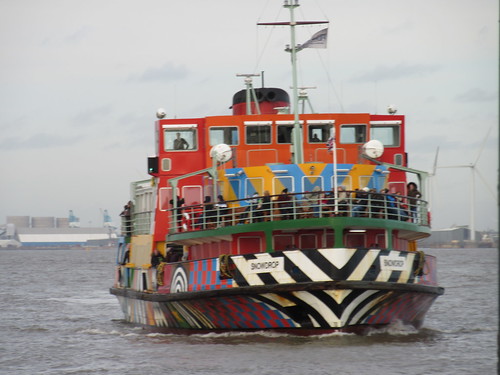 Birkenhead: 'Snowdrop' approaching Woodside Ferry Terminal.
Birkenhead: 'Snowdrop' approaching Woodside Ferry Terminal.
The short trip back to Liverpool gave views of the Cammell-Laird Shipyard (website here) and RFA 'Fort Austin' which I believe arrived on the 29th June 2015. She is one of two Fort-class 'Solid Support Ships' (formerly called 'Fleet Replenishment Ships'). On 8th February 2014 I'd seen her sister-ship 'Fort Rosalie' in the Cammell-Laird Ship Repair Site in Birkenhead's West Float (reported here).
 Birkenhead: RFA 'Fort Austin' in Cammell-Laird Shipyard.
Birkenhead: RFA 'Fort Austin' in Cammell-Laird Shipyard.
Beyond 'Fort Austin', I saw 'Go Pegasus' which forms part of the fleet of Singapore-based Otto Marine. Constructed at Otto Marine's Batam yard in Indonesia, 'Go Pegasus' is Norwegian designed and DNV-classed as an Anchor Handling Tug Supply (AHTS) vessel. With a 24,000 b.h.p. power unit, it is suitable for work in harsh environments and is equipped with Dynamic Positioning 2 (DP2) capabilities. Dynamic Positioning is described in a Wikipedia article here. DP1 systems are essentially simplex, DP2 are dual-redundant with voting for higher reliability and DP3 uses three sytems with other features. There's a graphic comparison of the system layouts in a Marine Technologies PDF here.
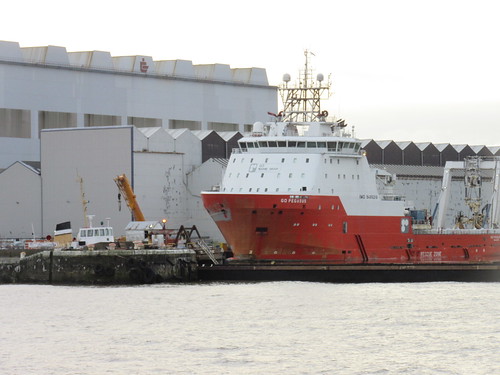 ' 'Go Pegasus' in the Cammell-Laird Shipyard.
' 'Go Pegasus' in the Cammell-Laird Shipyard.

This aerial view of the shipyard appeared on the Cammell-Laird site.
Whilst my attention was drawn to the shipyard, I hadn't noticed that we were being overhauled by a tanker heading upstream, probably to Stanlow. 'Stolt Redshank' (registered in Cardiff) is one of a large fleet of regional tankers, all named after birds, operated by Stolt-Nielsen Inter-Europe Service. This regional operation is part of the larger company Stolt-Neilsen Limited, founded by Jacob Stolt-Neilsen (1931-2015) in 1959 with one chartered ship.
 'Stolt Redshank' heads upstream.
'Stolt Redshank' heads upstream.
As our ferry manoeuvred towards Pierhead, another tanker heading upstream passed us. 'Aragonith' is an oil/chemical tanker operated by 'UNIBALTIC', a shipping company set up in Poland is 2003 with an informative website here with details of its fleet, including 'Aragonith'.
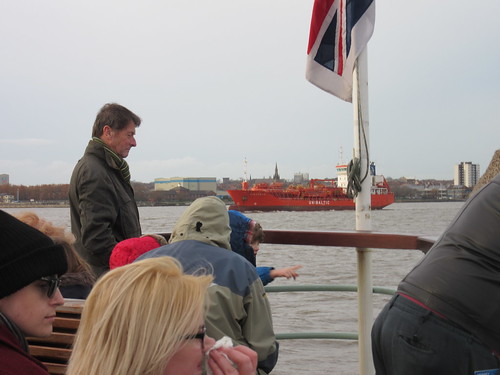 'Aragonith' heads upstream as 'Snowdrop' approaches Pierhead.
'Aragonith' heads upstream as 'Snowdrop' approaches Pierhead.
Homeward Bound
By the time I'd disembarked from 'Snowdrop', I thought I'd had sufficient exercise so I walked to James Street station and caught the next electric service to Lime Street. I was in good time for the hourly 'London Midland' service to Birmingham so I headed for home after an interesting (if tiring) trip.
Related posts on this website
There are all sorts of posts about Merseyside including:-
Birkenhead and New Brighton by train (Part 1).
Day Trip to Southport and Liverpool (Part 2).
More Merseyrail.
On foot around Liverpool Docks.
Preston to Liverpool by Rail.
My pictures around Merseyside
Liverpool.
Liverpool Docks.
Birkenhead and its Docks.
The Wirral.
New Brighton.
Liverpool area rail.
Merseyrail.
[Link to Cammell Laird updated: 7-Feb-2017]
